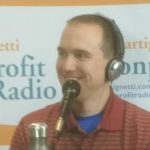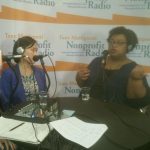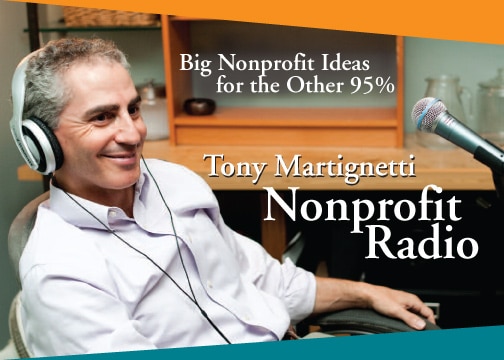
My Guests:
Michael Thatcher & Elijah Goldberg: New Year, New Charity Navigator
The rating site Charity Navigator has taken on impact reporting and vastly expanded the number of nonprofits evaluated. What does all this mean for your nonprofit? How do you get in on CN’s Encompass rating system? Michael Thatcher and Elijah Goldberg, both from Charity Navigator, chart your course across the freshly open waters.


Listen to the podcast
Podcast: Play in new window | Download
Subscribe to get the podcast
Apple Podcasts | Spotify | Google Podcasts | Stitcher
Get Nonprofit Radio insider alerts!
I love our sponsors!
![]() Turn Two Communications: PR and content for nonprofits. Your story is our mission.
Turn Two Communications: PR and content for nonprofits. Your story is our mission.
Dot Drives: Raise more money. Change more lives.
We’re the #1 Podcast for Nonprofits, With 13,000+ Weekly Listeners
Board relations. Fundraising. Volunteer management. Prospect research. Legal compliance. Accounting. Finance. Investments. Donor relations. Public relations. Marketing. Technology. Social media.
Every nonprofit struggles with these issues. Big nonprofits hire experts. The other 95% listen to Tony Martignetti Nonprofit Radio. Trusted experts and leading thinkers join me each week to tackle the tough issues. If you have big dreams but a small budget, you have a home at Tony Martignetti Nonprofit Radio.
View Full Transcript
Processed on: 2021-01-05T07:02:37.482Z
S3 bucket containing transcription results: transcript.results
Link to bucket: s3.console.aws.amazon.com/s3/buckets/transcript.results
Path to JSON: 2021…01…519_tony_martignetti_nonprofit_radio_20210104.mp3.745159472.json
Path to text: transcripts/2021/01/519_tony_martignetti_nonprofit_radio_20210104.txt
[00:02:42.94] spk_0:
Hello and welcome to tony-martignetti non profit radio. Big non profit ideas for the other 95%. I’m your aptly named host of your favorite abdominal podcast. Happy New Year. I hope you enjoyed the heck out of your New Year and the holidays. I hope you took time off. I hope the new year meant some time for reflection for you. Reflection backwards. Reflection. Looking ahead. Um, yeah, it’s a good time for reflection on. I hope you enjoyed the heck out of your holidays. Oh, I’m glad you’re with me. I’d be forced to endure the pain of neo and a phobia if I feared that you missed this week’s show. New Year New Charity Navigator. The rating sight charity Navigator has taken on impact reporting and vastly expanded the number of nonprofits evaluated. What does all this mean for your non profit? Have you get in on CNN’s encompass rating system? Michael Thatcher and Elijah Goldberg, both from Charity Navigator, chart your course across the freshly open waters. I’m tony is take two New year optimism. I can’t help it were sponsored by turn to communications, PR and content for nonprofits. Your story is their mission turn hyphen two dot ceo and by dot drives Prospect to donor. Simplified tony-dot-M.A.-slash-Pursuant for a free demo and a free month. Let’s kick off 2021 New Year. New Charity Navigator It’s my pleasure to welcome Michael Thatcher and Elijah Goldberg to the show. Michael Thatcher leads Charity Navigator in its efforts Toe make impactful philanthropy easier for all by improving evaluation methods so that more charities get rated. More potential donors view the ratings and all the stakeholders arm or engaged. Charity Navigator is that charity Navigator or GE? And Michael is at M. Thatcher. Elijah Goldberg leads the development of Charity Navigator’s impact ratings. He’s the former executive director and co founder of Impact Matters, which charity Navigator acquired this year. 2020 to incorporate impact estimates into its ratings. He’s at Elijah Goldberg. Michael, Elijah. Welcome to non profit radio.
Delighted to be here, tony. Thank you. [00:02:50.12] spk_0:
Thank you for [00:02:50.64] spk_2:
having us. [00:02:51.17] spk_0:
Pleasure to have you. Thank you. Michael. Why don’t you get us started? Um, just since July, Charity navigator is evaluating. Ah, lot more charities than you were earlier this year. [00:03:29.24] spk_1:
Yeah, and essentially, we’ve made a pretty big step change going from rating annually. About 9000 charities a year to reading 160,000. So exponential shift. And that’s primarily due to the fact that we have a lot mortuary teas now that our e filing their 1990 which is the tax form they use and were able to process that information with greater automation than we were in the past. [00:03:46.04] spk_0:
Yeah, well, I don’t I don’t want to quibble with with a numbers person, numbers and technology, person. But you say it’s exponential. 9000 to 160,000, but 9000, just 9000 just squared would be 81 million. [00:03:51.54] spk_1:
So it zig [00:03:53.79] spk_0:
to what’s sad, Elijah exponents could be fractions, right? Oh, Could be a fraction. Okay. All right. So it could be okay. Yeah. The point is, thank you. There’s a numbers person. All right. Thank you very much. So it doesn’t have to be a whole number. All right? So you’re Yes. Thank you. Um, I already got myself in trouble. We’re not even, like, two minutes into this. All right? [00:04:18.09] spk_2:
Uh, all the time. [00:04:18.75] spk_0:
All right. But I’m thinking at least I’m thinking about what you’re saying. I’m not I’m not just glossing over. All right, so, you know, from 269,000? Yeah. So I think a lot of people are still thinking you’re in there, like, eight or 9000 range. So we’ve got to dispel that misconception. Right away. 160. All right. [00:04:35.34] spk_1:
Yeah. Three other thing. Just. Well, the other thing that to say on that is what this is allowing for is it’ll. It’s opening up to smaller, newer in a very different set of nonprofits. And we’ve been looking at in the past [00:05:19.24] spk_0:
because of this automation I gather when it was I mean, I remember when it was just a few 1000 then it grew to several 1000. That was big news. Um, I don’t give a shout out to Ken Berger when Ken Berger was CEO. He’s been on. He was on the show a few times. Um uh, you have charity navigator. Um, but eso now, automation, you’ve you’ve scaled up considerably. Um, that’s which. Which benefits more charities. Which benefits more donors and potential donors. Um, yeah. So at the end of our conversation, we’re gonna get into what should a charity do just to get rated for the for the many that aren’t How did they get You know what we’re gonna talk about and encompass rating? How do they get an impact and result rating we’re gonna get? So we’re gonna hold that off till the end. Like, what do charities do to get these to get to the next level from where they might be? Um, but so, Michael, acquaintance with the Encompass rating system, which is also new. [00:06:55.74] spk_1:
Sure. And I think that’s really the key to the significant growth in the number of ratings. So encompasses looking to leverage, leverage, automation, where we can bring in information from through partners and then also directly from the nonprofits. It’s a system that’s broken up into four beacons or topic areas. And what we launched in July with was wth e financing accountability beacon, which is very similar to the ratings that we’ve been doing for the last 20 years through the star rated system In October of this year, through the joining of impact matters to Charity Navigator, we also launched the impact and results speaking, and that is adding a component of oven impact assessment to the ratings Now there is a smaller number that actually have that impact rating today. Coming next will be the culture and community beacon, which is going to be looking at things like how you engage with your constituents or, you know, beneficiary voice. Ah, diversity equity and inclusion with other elements of how the nonprofits engage with their community. And then lastly, we’re gonna be looking at leadership and adaptability, and that’s the fourth kind of real topic area. So it’s trying to give you a much more holistic view of a non profit that you would consider investing in as a donor. [00:07:16.14] spk_0:
Okay. And these air four beacons, right? If you’re [00:07:18.69] spk_1:
calling the beacons to stay in the navigation theme. [00:07:50.14] spk_0:
Oh, very clever. You see, I didn’t even realize. Okay. All right. You’re our compass, Jerry. Navigators are compass. Um, all right. So, Elijah, let’s let’s bring you in, eh? So what? What impact matters has added to charity Navigator’s ratings is the impact and results beacon. Uh, this is notoriously difficulty, but I saw you in one interview Say that you don’t really find it as difficult as you think. It often is considered to be this measuring of impact. [00:08:43.44] spk_2:
Yeah. Uh huh. I think there are different types of difficulty or their different difficulty could refer to different things. So e think the overall process of saying okay, we’re going to try and figure out take any non profit out there. What? What is its impact? And we try and do that at some degree of scale has proven a pretty difficult problem. We’ve been working on it now for for about five or six years on dhe, we’ve made some significant headway. We’ve, you know, we started with about 10 nonprofits. We got up to about 50 now worked about 1000 eso. There’s been Cem Cem progress there, but it remains a challenging issue on mostly that’s because of the wide sort of diversity [00:08:44.25] spk_0:
of diversity, of missions. Right, diversity. Education is a lot different than the impact of a soup kitchen is a lot different than the impact of a domestic violence shelter. [00:09:24.14] spk_2:
Exactly. And they all have different activities as well. And so you could have you have two missions that have two different sets of activities causing them, and and you have to understand the impact very differently. Even though the mission is the same similar you have to activities that have different outcomes, you know, So so s so that I think that that challenge is hard. I think the part that I was referring to that that I think is made out to be harder than it needs to be often is for it individual non profit to invest in understanding its own impact. Ah, nde the it’s not, you know it is a. It is a process that requires effort and attention and so forth. But often the standard is the, you know, something that came to the academic standard of proof, which is a which is a very high bar on dhe. There’s a lot of barriers and and sort of impediments that are placed in front of a non profit thio to go down that path. And what we realized is not for every non profit but for ah you know, a large chunk of them, uh, they can understand their impact in kind of a meaningful way through a much more simple process, much more simple way. [00:10:10.34] spk_0:
So how have you ratified this? Simplified this so that charity navigator could begin the ratings an impact evaluation. The key thing [00:10:11.15] spk_2:
that we’ve we’ve sort of hit on is this idea of we call them kind of program types. But this idea that you could look at a kind of, ah collection of activities that an outcome together and determine that they are, uh, that they could be used Thio to create a pretty straightforward calculation to figure out the impact of that organization. So, uh, in other words, like, if we look at, uh, you know a filter program, you know something is distributing clean water filters. We can look at the type of filter from that. We understand the efficacy of the filtration. We understand the longevity of filtration. We could know something about the, you know how many are distributed in a particular area, and we can understand what the coverage rate of clean water was in that area and how quickly it’s growing year over year. All of those data points are fairly easy to get. I mean, they’re not, you know, they’re not. You don’t just walk off the street with them, But most nonprofits are able to get that information, and we can then combine that with a ZX needed estimates from the literature and, you know, academic publications. And, you know, great literature like the U. N. Reports and so forth. Um, in a equation that will come to a cost effectiveness, come to an impact estimate number. [00:12:30.54] spk_0:
Okay, Right. So and we’ll get to that. That’s part of what you’re alluding to is the counterfactual. What? What would have happened if the organization hadn’t been providing service? Um, so So you’re talking about it. So it’s a mixture of reported data directly from the nonprofits and publicly available data. Exactly. Yeah. Okay. It’s time for a break. Turn to communications. The Wall Street Journal, The New York Times? You wanna be in papers like that? I suppose. How about CBS Market Watch? The Chronicle of Philanthropy? Turn two has the relationships with outlets like these. So when they’re looking for experts on charitable giving, non profit trends or philanthropy, they call turn to turn two calls, you turn hyphen two dot c o. Now back to New Year, new charity navigator. And [00:12:30.88] spk_2:
you know I mean the typical kind of the best in class, so to speak, the gold standard is Okay. Let’s run a large, expensive long term trial that looks at specific outcomes for this population. This activity, it [00:12:45.27] spk_0:
requires a couple of PhDs or at least a couple students a couple of years, right? [00:12:51.40] spk_2:
Yeah. Yeah. And so and that’s gonna give. I mean, that’s definitely gonna give the quote better answer. But the trade off, as you say in terms of the staffing of the time of the money and so forth, is usually not worth it. I mean, it’s much better for most nonprofits. Get a number that’s not quite as accurate, but is actually much faster, much cheaper, therefore, much more actionable. Okay, He’s [00:13:17.34] spk_0:
okay. Um, and your well, let me ask that. I do wanna do a basic question, Michael. How does how do these encompass ratings relate to the star ratings that people I think are very familiar with 0 to 5 stars? Uh, yeah. What’s the relationship there, if any, or how did they coexist? [00:14:22.94] spk_1:
So right now, they’re co co existing in parallel. And if you think about it, the encompass rating is what in the accountability and or the finance and accountability Beacon is a subset of what goes into the star rating. The star rating has a eligibility criteria which is a bit. It’s a higher bar in that we’re looking at organizations that air over a million dollars in revenue, seven years of tax filing and 40% of the revenue coming from individual donations. Encompass doesn’t require we need three years of continuous data, uh, and file data. So we’re we’ve reduced that to three years. We’re also the only four were only requiring that it be a 9 90 that we used to base that information over time. The goal is to harmonize the two systems and and bring them together so that we don’t have to systems running in parallel. The reality is, encompasses a fast moving growing system. It tze leveraging software development techniques like agile to reiterate relatively quickly with something that’s, you know, good enough or, ah, minimal viable product. And then we’re gonna iterated on time. So a big part of our development process right now is gathering feedback from donors, nonprofits, other users on How is this working for you? And in that spirit, you know, we’ve we ran a survey across about ended up about 1500 responses in the at the end of September, and we’re right now we’re tracking at about 84% satisfied or more than satisfied in terms of how people are receiving the new system. [00:15:24.94] spk_0:
What’s your goal for the end of 2021 for how many will have the encompass rating? Um, it part of that [00:15:26.95] spk_1:
is gated right now by E filing. And so the number is going to go up significantly as more and more organizations consistently e file, [00:15:35.70] spk_0:
you know, because [00:15:36.68] spk_1:
legislation So it will, you know it’s gonna grow by itself. [00:15:48.34] spk_0:
Because the organization needs three consecutive years of e filing of the 1990. This [00:15:48.82] spk_1:
may be getting into too much too much into the weeds way, non [00:15:55.28] spk_0:
profit radio listeners. Very savvy group we can we [00:15:57.50] spk_1:
can handle. No. But what’s happening now is that you’re going to start having organizations that may not have a 1990. But they do have an impact impact and results score or one of the other beacons will fill in. And so that’s gonna still result in some scoring and basically information for donors to look at in there giving decision, [00:16:17.34] spk_0:
Okay, But they will be penalized no for not okay, [00:16:21.35] spk_1:
Okay, It just won’t be counted. It won’t be factored in. [00:16:34.14] spk_0:
Okay. All right. Um, Elijah s o. A basic question for you. I feel like we should distinguish between outcomes and impact. I’m not sure that that’s clear in everybody’s minds. I hear them used interchangeably, and I try to be careful not to do that. You make that distinction, please. [00:18:34.94] spk_2:
Well, it’s a It’s a good question. I will say that we we have got We’ve gotten to the point internally where every word we use, we kind of define it ourselves because of that exact problem that that so much of the so much of the lingo is intermix that if we just assume people know what we’re saying, then then we’re gonna be in trouble. So I don’t think that that that’s just to say, like, I don’t think there is, like, a clear, universal answer the way that we distinguish it. Is that an outcome, you know, refers to, uh, typically, uh, like a change in in something that we care about What? The user. So it might be a change in their salary Or so I mean, I was talking users. I should be talking beneficiaries or participants. Okay. Uh, you know, change in salary, you achievement of a job so forth. Then we want to think of counterfactual outcomes. So those air what would have happened without the program? So, you know, without the program, would they have done the job? That’s the counterfactual outcomes, you know, Maybe without it they wouldn’t. That’s the counterfactual outcome with the program they did. That’s the outcome. And then when we when we take the difference of those those air the net outcome. So those were like, What? What is actually being caused by the program? We actually to get to impact, then take those outcomes and divide them by cost. We think of impact we define impact is being actually out cost, not just outcomes. Um, and that’s like That’s That’s kind of our definition. That’s not a, you know, ah, universal definition. I think the reason we we settled on it is because you know, the notion of outcomes without cost is is a little meaningless. It’s it’s difficult, you know. Even organization said we save five years, five lives last year that could be a large number of small number. I mean, if it’s a if it’s a community health center. That’s a large number. If it’s the Red Cross, I don’t know. I mean, that’s that’s Z. You know, there’s been a couple billion a year, so we have to understand, you know, we have to add costs of that equation to really understand what the outcomes mean. Okay. All right. [00:18:52.14] spk_0:
Well, again, you know, you guys spend your days thinking about this. Uh, e think the more common understanding is that but it is not to supplant what you just described. I’m just saying, You know, I think most people understand that is like using your water filtration example. The outcome would be we distributed 150,000 water filters. But the impact would be lives saved or cholera avoided, or other insect born what waterborne diseases avoided or something like that? [00:19:57.84] spk_2:
Yeah. I mean, that’s a That’s an interesting point. I mean, I think that a lot of I think you’re writing often that the distinction, you know, is between the sort of, you know, to two factors. One is like the tempo temporal ity of it is that, like a non upstream or downstream out outcome like that happened right away to happen later and also like the significance Is that something we really care about or we care Onley instrumentally about we We sometimes use the term or often use the term intermediate and final outcomes Thio to distinguish between those two. Um, or we use the term proxy to say that it’s actually it shows that the outcomes moving, but not the actual. But all of this again is like it Z There’s never gonna be in agreement, right? Like, way put the flag in the sand of like what we’re calling things that were internally consistent. But we recognize that that’s that’s just [00:20:07.34] spk_0:
us. Okay, Okay. Alright. Aggression, impact. Versace’s a sort of a [00:20:12.42] spk_2:
lot of confusion, I think because people use the same term but mean different things and don’t kind of get to the point of of that exact clarification that you ask for. I [00:20:33.04] spk_0:
think it’s definitely true. Yeah, yeah. Um, all right, so there’s a lot of social science methodology at the heart of this at the heart of these things. Impact rating. Can you Can you say what we’ve what? We’ve what you’ve transported from social science research methods, thio, non profit impact evaluation readings. [00:21:13.34] spk_2:
Yeah. I mean, I think that at a fundamental level, we’re following, you know, the, uh you know, the science of causal inference. Right? So how do we understand that A actually causes B? Ah nde? And there’s been, you know, a lot of work in the academic world over last couple 100 years to build both the theory and the methods of doing that on dhe largely. You know, there’s a lot of different pieces of that, but like one of the major pieces that that kind of you know, crops up again and again Is this question of the counterfactual right? Especially what would have happened? Um, had we not intervened had, you know, had had this ruler stayed in power for that? I mean, anything that happens in the world, we could say, Well, what would have happened if that didn’t happen on dhe? Sometimes that’s more of an academic exercise. But when it comes to social programs, it turns out to be a very important one because we’re making choices over shared resource is social resource is of some sort. We’re making a choice to do something with those to try and solve a problem we could have done something else. And in the future, we’re gonna have the choice. Usually Thio do one or the other again. A [00:22:11.24] spk_0:
question of how much does the charity deserve credit for? Exactly. And and And also, I mean, how much this would have happened on its own. And I think [00:22:12.39] spk_2:
that partially it’s it’s about, you know, that that framing. And it’s also about from the non profit perspective. Okay, I did this the last year. Should I do it for the next year, You know, or should I Do you know plan B? It’s that type of decision making, and so so a sign. I mean, the social sciences have built a kind of a large edifice of theory and data and and best practices around how to do that. We have basically, like, picked some of the key points and intentionally ignored from the other points in order to build something that’s sort of usable within the nonprofit world, which is very different than the academic world. Um [00:22:51.80] spk_0:
oh, yeah, Well, yeah, the academic world is the, uh, longitudinal sir study that we’re talking about a few minutes ago. Yeah, all right. And and so [00:23:01.82] spk_2:
I mean, I will say so. There are some non profits out there that are doing really high quality academic studies, often in partnerships with academic institutions. And that’s been a huge explosion of the last couple decades. But that’s still like the 0.1%. I mean, it’s a small fraction. It’s important for action, but it’s a small [00:23:41.44] spk_0:
um yeah, on those air. Not our listeners. Our listeners air small and mid sized shops. You know, they’re they’re probably not affiliated with the academic institution. They might be one themselves, but not doing the kind of research we’re talking about. Um, so we try to keep it. Really? Um, so now I guess I think this is better for you, Michael. Uh, eso the impact of results. Score is still in beta. Is that right? [00:23:47.64] spk_1:
It’s It’s already live. No, it’s You know, technically, this with encompasses a beta system, as as we build out the beacons. But we have What’s the number of larger? The total encompass ITT’s about 6 700 right now. [00:24:05.74] spk_2:
Yeah. We have 700 on way, have 700 on the compass profiles, and then about 300 on the, um seeing 2.1 that are not part of the score there. Just [00:24:32.94] spk_0:
informational. Okay. All right. So do they have to be, um, direct service organizations? Still is that I saw three criteria direct service and and receiving private charitable contributions. Is that still the criteria for, uh, getting an impact? The results score that your your direct and your service. [00:25:20.64] spk_2:
Yeah. Yes, that that is. And I think we’re, uh you know, the type of analysis that we dio just doesn’t work for groups that are doing things like advocacy that that we don’t have. I mean, again, we talk about social science, the causal inference, tools. They break down with a with a program like advocacy because, you know, we it’s a single shot the, you know, three of changes longer and so forth. Um, so we’re really limiting it to that, because that’s what we think that we can say something meaningful about with the current system. There’s a perpetual desire, and like I’ve had, I’ve been in a conversation every two months for the last six years, where it’s come up about doing advocacy. We definitely want to do it. You know, I will say that we’ve said that for every two months for for six years. I think that we don’t have a good way of doing that. And not to say we never will. But we haven’t figured out a way that does it in a way that’s kind of fair and meaningful. [00:25:39.20] spk_0:
Okay, well, you get there. I mean, this is E. I’m feel like I’m talking to the musk’s off charity evaluation impact impact. [00:25:48.45] spk_2:
I also planned to be 100 billion here also. This. Yeah. [00:26:10.24] spk_0:
All right. Well, if I was, if I could buy stock and Charity Navigator, I probably would, because i e I wish I had bought Tesla at 200. You know, pre split. Um, so So you know, I understand it’s something you’ll get to, but I just want to make it clear that, like education is not is not Doesn’t fall within your definition of of service, because the beneficiaries they’re supposed to be paying little or nothing for the service that they’re getting. And education is a tuition model. So education doesn’t fit yet either [00:27:08.09] spk_2:
some of it doesn’t. Some of it doesn’t way have a basically we’re looking at It’s okay. If the participants based some, we just don’t want them to be. We don’t want it to be mostly a service that is like essentially mirroring a for profit service, but with kind of a non profit structure in terms of how you know how the money flows. So we have done like scholarship programs that are, you know, or their interventions like de worming that actually do increase educational outcomes we would do. But like what we won’t necessarily do at this point is something like a like a private school. Um, you know, we may do the scholarship program of the private school if that was a separate entity and doable, but we wouldn’t do sort of the main. But we would do, for instance, like a high performing charter. [00:29:21.84] spk_0:
It’s time for Tony’s take two. I am always optimistic at the beginning of a new year. I can’t help it. Of course, last year’s optimism was misplaced. Nobody is 100% s O. That one didn’t work out so well, but I’m still optimistic. I can’t help it. At the end of the recession, I was still optimistic the year after, So I am optimistic about 2021 as I mentioned earlier at the open. Hope it was a time for reflection for you. I know it is for me. I just think good things are gonna happen. Um, I’m launching plan to giving accelerator. We’ve got our first class for that excellent and non profit radio feeling feeling, you know, less constrained now. Yes, it’s been since. I think, since August, I’ve been doing these outside the studio and deviating from the district one hour format. It’s not necessary. It’s not necessary. So, like, today’s show is about gonna be roughly 45 minutes or so, Um, so feeling a little freer about non profit radio? The guests are still awesome. You know, the hostess still lackluster. You know, the core principles don’t change. We’re not not fooling with those things that folks rely on. What would you call something that you rely on on those, uh, foundations? Those bedrocks of non profit radio? Those those don’t change but a little tinkering, you know, the time doesn’t have to be an hour. I realized it could be we could be having our non profit radios. So don’t don’t think that long format is being abandoned. It’s not. But as I said, Just feeling a little less constrained. And how about you? How about you for 2021? Optimistic. I hope. I hope that is. Tony. Take two. I’m optimistic. What can I say? Let us return to New Year. New Charity Navigator with Michael Thatcher and Elijah Goldberg. [00:29:47.04] spk_1:
It’s worth noting in the star system that z similarly been applied that we tuition based schools. We haven’t been rating where we stopped rating, and then we work. We did continue rating those that were like the Harlem Children’s Zone or other schools that were fully subsidized by their donors. And there was not. Tuition was not an element. [00:30:10.24] spk_0:
Okay, so it’s still still a possibility. Okay, um, So before we get to the nuts and bolts of how nonprofits get to the next level in Charity Navigator, based on whatever they are now, what else do either one of you want us to know about about encompass or impact and results? [00:31:21.14] spk_1:
The one thing I’d add is, Is this idea of, you know, particularly you have the impact discussion. It’s It’s oftentimes described in the element of the the social change. One is seeking to to arrive at and charity Navigator really is looking at, and that would be the result of program program effectiveness of a non profit and charity Navigator’s ratings have always, you know, over the years been looking at the non profit as an entity and less the less the programs, particularly given the star rating, which was looking at the finances and then the accountability and transparency. And so there’s an element of that where we’re trying to evaluate, and what encompasses trying to do is give you an impression of how is this organization as a potentially impact making machine? But not, you know, the impact is a key part of that, and we clearly that’s why were we make gifts to charities into the non profit. But it’s also you want to know that you have a strong organization that’s gonna grow, evolve and learn and continue to do better as it goes forward. So it’s more. It’s a progressive system that’s really trying to help move folks to an idea of investment in an entity that is making impact. [00:31:54.44] spk_0:
Do we have any proof that knowledge of impact changes donor donor outcomes, donor behaviors? I mean, it’s it’s intuitive, but do we know that this enhanced knowledge changes donor giving decisions? [00:31:58.04] spk_2:
I mean, I think that that’s that would be be a topic for like, a fairly dry I’m interesting chapter book. There’s a lot, a lot there, Thank you. [00:32:07.78] spk_0:
Well, you’re stuck with a lackluster host. I didn’t think the question was bad. Book. The book may be dull, but my question was decent. [00:33:47.41] spk_2:
E. I think it’s the reason why it is just because it’s so There’s no there’s no, like, really good crisp answer to that. That’s that. I mean, it’s a very important question. We just don’t quite have the answer. I mean, there have been probably, at this point, about a dozen, you know, depending on how you count studies have been done over the last five or 10 years. That that a probe, that question, um, you know, a handful of our data, often with other other data. It’s a pretty mixed bag, like we’ve seen results that show that presenting impact information really does boost donor behavior pretty significantly. There have been other findings that have found that it has little effect. It seems that matter a lot about framing, you know, that’s a level, I will say that the major donor level, it’s a It’s a somewhat of a clear split. Basically, there’s sort of two camps. There’s the three camps. There’s like we don’t ask anything about impact. There’s the We want you to say something about impact in your grant application. But does that. And then there’s the camp that takes it very seriously. On Dhe, that camp is still pretty small, but they do command, you know, substantial resource is it’s like give well on its donor base. Robin Hood Foundation malago Foundation groups like that on DSO. There is like a pretty hefty sort of institutional a group of donors there. Uh, so that’s the ZX like, kind of a broad rose, but the bottom line is, it’s a pretty murky, messy answer. [00:34:29.44] spk_1:
But the other data point I could give you tony more from sort of the general public, which has been traditionally charity Navigator’s audience, and the donor base is it’s probably the most demanded thing. We want to see impact in our donor surveys, but how that gets articulated in their actual behavior. It’s harder to tell right so that we have less good data on. We know they’re asking for it, but they’re also asking for low overhead ratios, right? And so you have this kind of conflicting, um, Senate demands in many cases, and but being able to show it to be able to show it with some form of clarity, I think would really help people get their minds around it. You know, we spent a lot of time just defining it in this call. Eso That’s part of the problem, [00:34:43.44] spk_0:
right? Right now, you just mentioned the overhead ratio. Is that still? Is that still out there? Is that still people still looking for 95% to go toe program? And they’re considering overhead and investment? Ah, bad thing [00:34:58.84] spk_1:
it’s It’s probably the most you know, particularly when you know, if I get into, you know, talking to mainstream media or you know that that’s the first question that asked, You know, you want to know that all your money is going to program, so unfortunately, it’s still it’s a very prevalent question in a very prevalent focus. [00:35:32.74] spk_0:
Okay, non profit radio has a little part in that history I had the three CEOs on the eso is Ken Berger from charity Navigator, uh, Jacob from Guidestar. And gentlemen, who is our Taylor? Thank you very much from the Better Business Bureau. Wise giving alliance. So I had the three of them on together when they signed the letter that said, Stop doing T the American public. Stop doing what we suggested you do on DSS. Stopped looking for 97% program because, you know, there could be it could be a very legitimate I mean, overhead is important. Overhead is technology and salaries and CEOs and program people and and infrastructure and security and accountants building maintenance And [00:36:05.81] spk_2:
what accountants? Who’s gonna tell you how much money you’re setting? [00:36:33.53] spk_0:
Accountants? You know, it could be investment in a long term program that reward us for five years, so Okay, well, whenever it comes up, I get on a soapbox. But I we tried, you know, we, uh, we had Well, of course, we’re talking to non profit. So the nonprofits understood that all along, but we did have the three CEOs on for a little bit of a mea culpa. Uh huh. Thio when they signed the letter saying, Stop doing this. Stop looking only at overhead. You [00:36:38.75] spk_1:
know historic that there was the second letter that got sent out. I don’t know if you’re aware of that, because that first letter went out to the donors to the to the public. And then the second letter went out about a year and a half later, saying to the non profit, You got to report on your impact. [00:36:53.83] spk_0:
Yeah. This is the first letter that went to the American public. It wasn’t that literally, but yeah, yeah, [00:37:01.87] spk_1:
Tell us what you did. [00:37:44.03] spk_0:
Yeah, Still hypocrisy there. Uh, or these some dissonance. All right. Um, okay, So if we’re not, I assume this is for you, Michael. If we’re charity, that’s not rated at all non profit. I’m sorry. It was not rated by non profit radio was what I was about to say. Not rated it all by charity Navigator. Because the world revolves around this show. And me, you know, it’s center of the universe is all your all your your your careers, to this point of driven you to this thing. This pinnacle, this zenith, I I know it because I because that’s it. I just know that that’s exists. It’s just assumption. It’s just a known, so I I know it’s just a given. Its it’s not even, uh, there’s no counterfactual. Can’t be argued. So any case, um, if our non profit is not at all evaluated, we’re not even on the charity navigator radar. How did we just get to that level? [00:39:10.92] spk_1:
So the simplest is you gotta e file and that soon going to be law that that will be your only way of filing that Just get your 9 90 into the system. Once we have three years worth of 19 nineties, we will. We will have enough information to to issue of some form of a rating. The other thing is, if you’re a registered registered 501 C three charity, we already have you in our database. So the ways of getting additional information in there are to submit information to guide. Start now candid, particularly looking at things like the There is how we listen. Optional component of the GuideStar profile that is going to be in part, something we use for the constituent voice evaluation that’s going to be going live in, probably in March of 2021. So you want to get your data into the different data platforms. We’re also working on a portal right now that will allow charities to submit information to us directly. So that will be another means on dhe that is in process. Right now, it’s not built. Um, the other thing is, um, yeah, make yourself known to the to the different portals that collect information. That’s the best way of getting your information other than just your 9 90 information into the hands of evaluators like ourselves. [00:40:17.81] spk_0:
Time for our last break dot drives relationships, not with journalists. Now we’re talking about relationships with prospects. Your challenge is engaging prospects so they become engaged donors. If you want to move the needle on your fundraising relationships, look at dot drives. The simplest donor pipeline fundraising tool Move folks from prospect to donor, get the free demo for listeners. There’s also a free month. You go to the listener landing page at tony-dot-M.A.-slash-Pursuant. We’ve got a butt cheek, more time for New Year new charity navigator, and if we want to go to the next level now, if we want, uh, if we want a encompass rating, how do we get to there? So that will [00:40:20.31] spk_1:
get you when I was just speaking to will get you the information that would get your finance and accountability [00:40:25.44] spk_0:
school financing account. But right, the 33 consecutive years. Okay, if you wanna go broader with the other beacons, [00:40:31.51] spk_1:
do you want to speak to that with the what we’re doing in the forgetting? [00:40:59.01] spk_2:
So for impact, we we have, ah, sort of, ah, early version of the portal that zone impact cherry navigator dot or GE It will eventually grow into the broader portal that Michael talked about, but that that’s the place to start. If you you know, if the non profit goes there and goes to the process, will take a look at that data. Uh, we’re still, you know, from from our perspective, we were doing a lot of work right now to invest in sort of as efficient a system as possible for rating. Um, the problem with impact rating that we’ve struggled with for our entire existence is that it could be very time intensive. Andi, even if even as we kind of cut down the time intensive ity as we try and increase the scale of ratings and kind of keep our team not. Not too much larger, uh, than you know it. It fast becomes impossibility. So that’s what we’re hoping to do with the portal. And, you know, well, you know, usually goes now, impact on trade navigated a torque. Either they’ll they’ll have, you know they’ll qualify for rating now, more likely, given where our methodology is, we’ll ask them questions and we’ll get back to them soon. Once we have kind of mawr coverage for different types of programs, I can talk a little bit more about that. That’s a little bit of nuance, [00:42:22.50] spk_0:
but so the goal is whole number. Exponential growth. Yes. Okay. Okay. Yeah, at least a square. Okay. Uh huh. And all right, so And the the site again is impact charitynavigator dot or ge. Right. And you can submit data there. Okay. Okay. All right. You leave it there. What do you think? I would just add [00:43:44.20] spk_2:
one thing, you know, that I was gonna mention before, but it’s a little bit of a tangent. I think it’s always worth mentioning is one of things that we’ve found in our work, which was, I think, actually fairly surprising. Kind of given our Prior Tze when we really started this back in the day. But most groups that we that have gone through this process we found have actually been cost effective on many of them have been have been highly cost effective. So of the of the about, you know, you know, out of 100% about 87% of the group’s we’ve worked with have have, you know, have been sort of been determined to be cost effective or highly cost effective. I think that’s just an important message to share kind of Ford on profits in general. Because, you know, there’s there’s, ah, there’s often, uh, uh huh you know, a perception or ah kind of Ah, a sort of, ah assumption among the public that non profit, they’re not efficient, that that the private sector, the free markets are efficient, non profit, they’re inefficient. Sure, they’re doing good things, but we should be We should be kind of concerned about how they do them on the data shows. That’s that’s really not the case. They there pretty good at achieving, you know, unless unless you as a donor, choosing very, very poorly about which non profit you’re giving, Thio odds are the non profit you’re giving to is pretty effective. It [00:43:44.27] spk_0:
sounds like the way I buy stocks. Buy high sell, buy high, sell low. That’s my If you look at my portfolio, you’ll see, uh, you see that lesson, uh, come to fruition? Um Oh, and since I’m talking to data scientist, I want to correct myself. So the objective is not necessarily whole number. Exponential growth, but exponential growth greater than one? [00:44:08.09] spk_2:
Yeah, we’re looking for, like, adding in order. Yeah. I’m sorry. We’re looking at an order of magnitude at another zero. Okay. [00:44:13.79] spk_0:
Okay. All right. Michael Thatcher leads Charity Navigator, charity navigators at charitynavigator dot or GE and Michael’s at M. Thatcher. Elijah leads the development of charity Navigator’s impact ratings. He’s at Elijah Goldberg, Michael and Elijah. Thanks very much. Pleasure. [00:44:30.99] spk_2:
Thanks so much for being on [00:45:28.49] spk_0:
next week. P p p. Two. It’s the paycheck protection program reduction with who else? Jean Takagi. Naturally, if you missed any part of this week’s show, I beseech you, find it at tony-martignetti dot com were sponsored by turn to communications, PR and content for nonprofits. Your story is their mission. Turn hyphen two dot c O and by dot drives Prospect to donor Simplified tony-dot-M.A.-slash-Pursuant for a free demo and a free month. Ah, creative producer is Claire Meyerhoff. The social media is by Susan Chavez. Mark Silverman is our Web guy, and this music is by Scots. Tony, thank you for that affirmation. Scotty, be with me next week for non profit radio. Big non profit ideas for the other 95% go out and be great.












